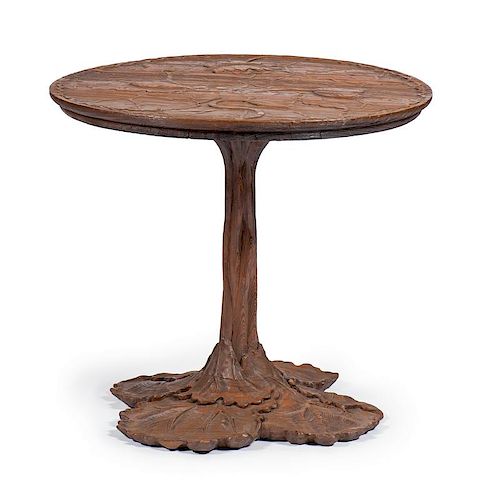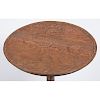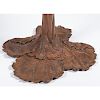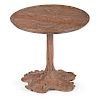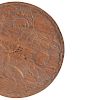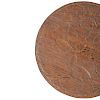A Rare and Important John Scott Bradstreet <i>Jin-di-sugi</i> "Lotus" Table
About Seller
6270 Este Ave.
Cincinnati , OH 45232
United States
With offices in Cincinnati, Cleveland and Denver, Cowan’s holds over 40 auctions each year, with annual sales exceeding $16M. We reach buyers around the globe, and take pride in our reputation for integrity, customer service and great results. A full-service house, Cowan’s Auctions specializes in Am...Read more
Two ways to bid:
- Leave a max absentee bid and the platform will bid on your behalf up to your maximum bid during the live auction.
- Bid live during the auction and your bids will be submitted real-time to the auctioneer.
Bid Increments
| Price | Bid Increment |
|---|---|
| $0 | $25 |
| $500 | $50 |
| $1,000 | $100 |
| $2,000 | $250 |
| $5,000 | $500 |
| $10,000 | $1,000 |
| $20,000 | $2,500 |
| $50,000 | $5,000 |
| $100,000 | $10,000 |
About Auction
Oct 20, 2017 - Oct 22, 2017
Cowan's Auctions dawnie@cowans.com
- Lot Description
John Scott Bradstreet
A Rare and Important Jin-Di-Sugi “Lotus” Table, Model no. 96
ca 1905
cypress
ht. 27, top dia. 29.75 in.
John Scott Bradstreet (American, 1845-1914) was a leading interior designer and decorator in Minneapolis at a time when the city was experiencing rapid growth and an increase in the demand of high-style household goods. He settled in Minneapolis in 1873 and soon became an influential tastemaker in the Northwest. Bradstreet was heavily influenced by the English Arts and Crafts movement and modeled his Craftshouse on William Morris’s Kelmscott workshop. Craftshouse, opened in 1904, showcased Bradstreet’s artistic furniture designs alongside an array of antique and contemporary objects purchased on his frequent buying trips to Europe and Japan. Craftshouse served as a showroom, museum, atelier and salon and was separated from the street by extensive Japanese gardens. Bradstreet’s designs for furniture and interiors synthesized the vocabularies of many of the historical revival styles of the day, including Gothic, Moorish, Near Eastern and Asian.
Bradstreet’s interest in the art and culture of Japan culminated in the development of an exquisite line of furniture based on ancient jindai-sugi carvings, which he discovered on a visit to Japan. Jindai-sugi is a traditional method of carving Japanese cypress which have naturally broken down fibers due to water and mud exposure over many years. Bradstreet developed a method of creating a similar effect in a shorter period of time in a technique he called jin-di-sugi, or sugi. The technique involved searing the surface of the wood and scrubbing it with a wire brush. The exposed raised grain of the soft surface would then be carved by hand and stained or painted. This technique was applied to Bradstreet’s most important commissions, such as the William Prindle House in Duluth, Minnesota, where the “lotus” table was featured among other artistic furniture and sugi paneling in the living room. The jin-di-sugi finish is considered to be one of Bradstreet’s most important contributions to the American Arts and Crafts style.
The “lotus” table is one of Bradstreet’s finest examples of the sugi style. He advertised the table as early as 1903 in the Western Architect. The table, featuring intertwining lotus blossoms, a popular motif in Asian art, is a brilliant example of the designer’s ability to merge Western and Eastern aesthetics in one piece. The carving shows Bradstreet’s loyalty to the Japanese sensibility of abstracting nature.
There are fewer than ten known examples of the “lotus” table. Several have surfaced at auction (Sotheby’s, June 17, 2004, lot 6; Christie’s, June 13, 2008, lot 118; Sotheby’s, December 14, 2016, lot 221), one is in a private collection, and the others are in the collections of the Minneapolis Museum of Art, The Museum of Fine Arts, Houston and the Two Red Roses Foundation.
Provenance: Gifted to the consignor’s family in the 1940s in Minneapolis
Thence by descent to the present owner
Literature
Michael Conforti, “Orientalism on the Upper Mississippi: The Work of John S. Bradstreet,” The Minneapolis Institute of Arts Bulletin, LXV, 1981-1982.
Michael Conforti, ed., Minnesota 1900: Art and Life on the Upper Mississippi, 1890-1915, Newark, 1994.
Wendy Kaplan, The Art that is Life: The Arts & Crafts Movement in America, 1875-1920, Boston, 1987.
Sarah Sik, “John Scott Bradstreet: the Minneapolis Crafthouse and the Decorative Arts Revival in the American Northwest,” Nineteenth-Century Art Worldwide, Vol. 4, Issue 1, Spring 2005.
Condition
Original finish. Some small nicks to the base, including a 1.5" area of old loss to the edge. Some age cracks to the top and the underside of the top. A few dark areas in the carving on the top, which look original.
Eliminate the Hassle of Third-Party Shippers: Let Cowan's Ship Directly To You!
If you'd like a shipping estimate before the auction, contact Cowan's in-house shipping department at shipping@cowans.com or 513.871.1670 x219. - Shipping Info
-
Eliminate the Hassle of Third-Party Shippers: Let Cowan's Ship Directly To You!
If you'd like a shipping estimate before the auction, contact Cowan's in-house shipping department at shipping@cowans.com or 513.871.1670 x219.
At the request of the buyer, Cowan's will authorize the shipment of purchased items. Shipments usually occur within two weeks after payment has been received. Shipment is generally made via UPS Ground service. Unless buyer gives special instructions, the shipping method shall be at the sole discretion of Cowan's Auctions, Inc.. Cowan's is in no way responsible for the acts or omissions of independent handlers, packers or shippers of purchased items or for any loss, damage or delay from the packing or shipping of any property.
-
- Buyer's Premium



 EUR
EUR CAD
CAD AUD
AUD GBP
GBP MXN
MXN HKD
HKD CNY
CNY MYR
MYR SEK
SEK SGD
SGD CHF
CHF THB
THB